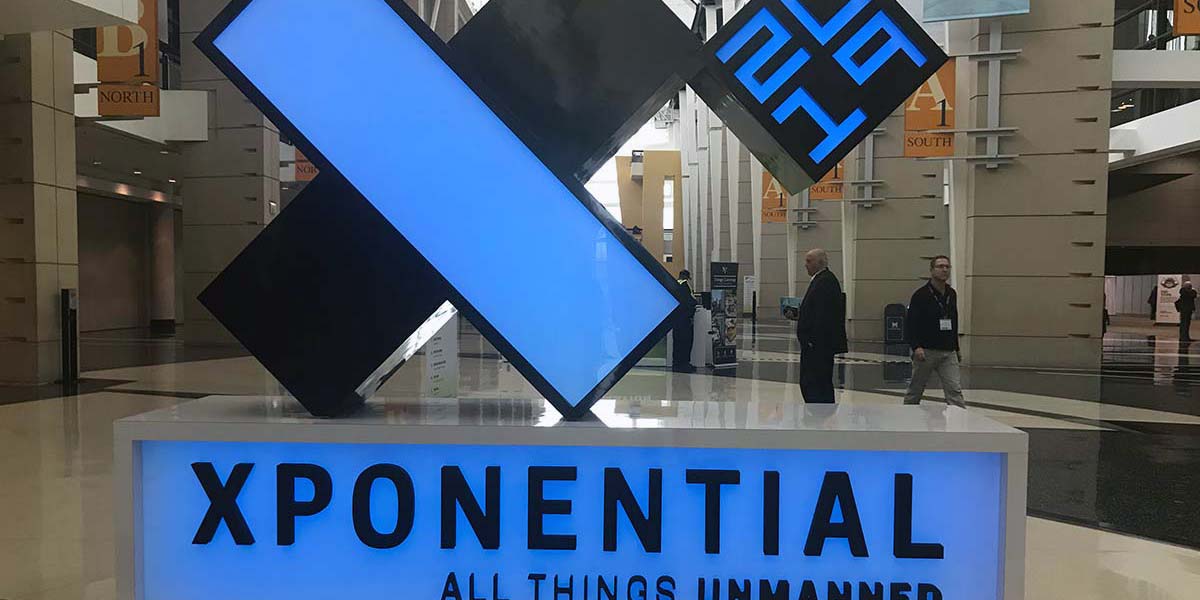
Servo Magazine ( 2019 Issue-3 )
AUVSI XPONENTIAL Trade Show Review
By Mark Essenburg View In Digital Edition
Welcome to XPONENTIAL! Here, you’ll discover what happened at the 2019 AUVSI trade show. “All Things Un`manned” is the largest annual event of its kind and showcases new technologies for many different robots. I explored the entire show, and this is my story.
Big trade shows are always fun and fabulous at the same time, but the 2019 AUVSI XPONENTIAL unmanned and autonomous systems event in Chicago set a new bar for me. It was as much an experiencee as it was a trade show.

Attendees and exibiters crowd the entrance all day.
The showroom floor was huge. Covering approximately 430,000 square feet of area, just walking from one end to the other took several minutes. Add in 700 or so booths of fascinating robots, and it could take you hours. However, the show is not one straight aisle across a vast room. It’s a veritable city of walkways and corridors.
After one look at the massive floor map, I knew I needed a plan. So, for the first day, I made a goal of walking the length of each aisle and at least getting a look at every booth. I tried not to stop much, but obviously, that was impossible.
I made it to the end with sore feet, several hundred photographs, and a fistful of cards from booths I would visit for a longer chat the next day. I sat down heavily among a group of similarly exhausted attendees, and we all agreed that we were amazed at what we were seeing.
What an adventure! People from all around the world crowded the floor, chattering away at each other in as many languages as you can imagine. I heard Mandarin, German, French, Spanish, and Korean, to name a few.
International booths included Canada, France, China, Denmark, Korea, Norway, and Spain. I interviewed the engineers at O.S. Engines who worked the show through a translator. As you can well imagine, that was an interesting conversation.
O.S. Engines is one of the companies that many of us are familiar with from their years of offering products to the hobby industry, but all these companies have professional and commercial divisions and are offering high quality, well-engineered products with innovative solutions to problems that robot operators are discovering in the field.
These are real robots doing real work in the real world, and that is really neat in my book.
With over 8,000 regulators, users, innovators, and technologists in attendance, it was easily the largest and most complete show in the Unmanned Systems industry. Networking opportunities abounded aplenty! Breakout meeting rooms and tables provided opportunities for folks to arrange meetings and make deals that could be followed up on in the coming weeks and months.
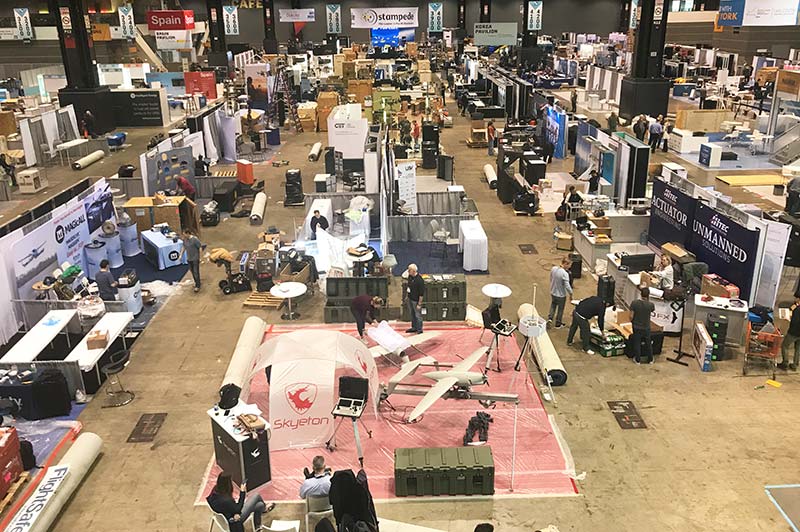
Setting up the largest unmanned system show in the industry.
Over 700 exhibitors displayed all types of unmanned systems (read: robots!). There were marine robots, terrestrial robots, and, of course, flying robots (drones!). There were so many drones that it was impossible to look in any direction and not see one of some kind.
Drones dominated the show, but that doesn’t mean the show was only about drones.
Two entire sides of the show floor were dedicated to the “low-speed demo” areas where self-driving cars plied simulated streets. Military prototypes of all-terrain vehicles navigated the field in both autonomous and remotely piloted modes. The low-speed demo area contained a variety of obstacles to avoid and had real world street markings.
There was a big trend at the show towards autonomy. Almost all the developers are working to take the pilot or driver out of the picture, or it’s at least part of their plans. This means that more and more, the robot will be performing tasks without human intervention.
Agricultural drones are leading the way on this front, using ground-based location transmitters to accurately position the aircraft and obtain excellent images for post-flight analysis. Some robotic highway inspection vehicles are designed to get the driver out of the danger of collisions by conducting the inspection autonomously.
One of the more exciting UAV systems on display was a drone from Planck Aero that could take off and land from a moving vehicle.
A demonstration video showed the drone approaching a truck moving over rough terrain, and the drone landing on a specialized pad mounted in the truck bed.
The military applications for this platform are obvious, allowing troops on the move to deploy observation drones without dismounting and taking the time to set up a launcher. This can significantly extend the visual range of platoons or squads and is already in use by the US Marine Corps.
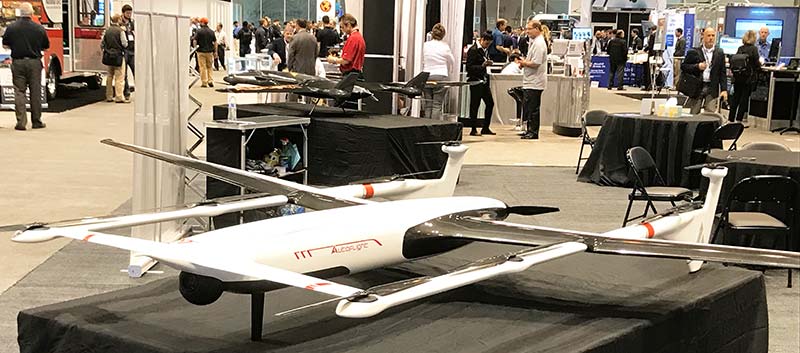
A fast winged drone capable of vertical take off and landing (VTOL).
Another big trend is hybrid UAVs that fly fast in level flight but can also slow to a hover to maintain a position or perform a VTOL (Vertical Take Off and Landing). Most of these employ some pusher or tractor mounted engine in a fuselage with a wing for level flight, and vertically mounted blades for hovering flight.
The Aergility ATLIS uses the same aerodynamics as an autogyro instead of wings. An autogyro — also known as a gyroplane or gyrocopter — is a type of rotorcraft that uses an unpowered rotor in free auto-rotation to develop lift. Forward thrust is provided independently; typically by an engine-driven propeller.
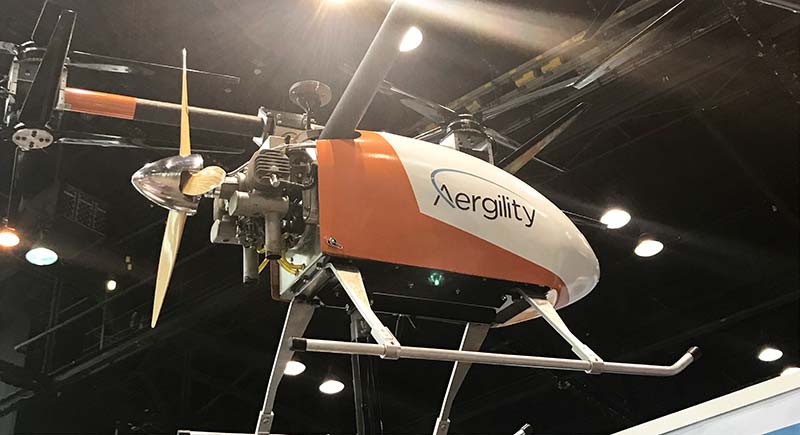
The Aergility ATLIS. Autonomous UAV for long range cargo delivery.
Using lift from the horizontal blades in the same manner as an autogyro, the forward motion creates lift from the spinning of the rotors.
This patented design results in a great by-product. The spinning horizontal rotors generate electrical power which is returned to the system in level flight somewhat like a hybrid car with regenerative braking.
Some drones like Bell’s Nexus “Air Taxi” use pivoting fan blades to achieve flight in both the horizontal and vertical realms. It’s hard, however, to call the Nexus a drone.
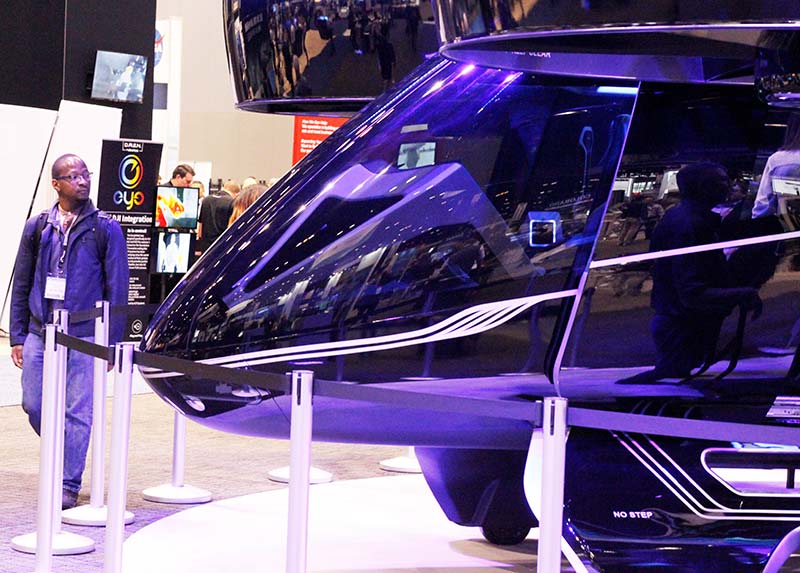
The Bell Nexus mockup gets a close inspection.
The mock-up Bell displayed was as big as an airplane and looked like the offspring of one of the helicopters in the movie Avatar.
The fans will be far quieter than conventional helicopter blades. Nexus fans incorporate innovative curved blade tips and a contoured shroud which are carefully designed to minimize operational noise.
Using a heavy fuel capable turbine engine to power a generator that, in turn, provides power to six electric ducted-fan motors, the Nexus will carry four passengers and a pilot with the goal of making the aircraft fully autonomous.
A Bell engineer said the first prototype could be test flown within two years. This futuristic vehicle may be commonplace within decades, giving us a glimpse of future urban life.
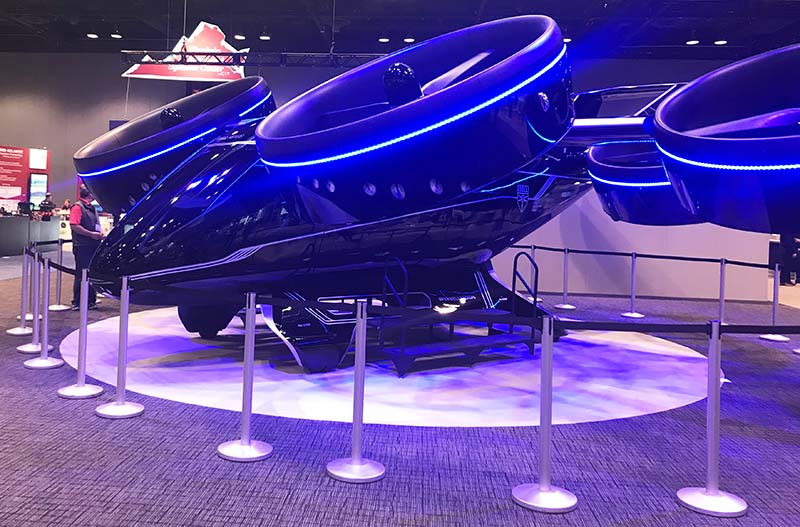
The ducted fan housings rotate to change from horizontal flight to VTOL.
Still, others take off vertically and then rotate the entire drone in the air to fly horizontally. The round wing is making a comeback!
Power systems are a category by themselves and encompass everything from turbines driving generators to full-scale airplane engines with 600 or more CCs of displacement burning heavy fuel.
It’s fun to see names associated with the hobby industry putting themselves into the commercial and military markets. Names like Futaba, O.S. Engines, Hitec, and Sullivan were present at the show with their professional lines.
O.S. Engines displayed an impressive line of single- and twin-engine power systems with fuel injection and onboard Engine Control Units (ECUs) that talk back to the computers in the drone.
The ECU provides many data points beyond the basics of engine speed control and gives the operators on the ground an excellent view of the health of the engine at any given moment.
A significant trend at the show was for power product manufacturers to be using certified airplane grade components. I heard this over and over, and it makes sense. If these systems are going to operate over populated areas and people or property are potentially at risk, then the FAA (Federal Aviation Administration) will have to make rules. Those rules are likely to include things that match up with their current standards.
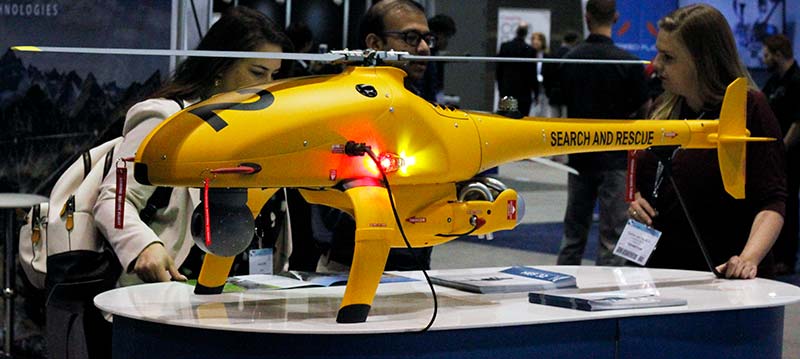
Search and rescue helicopter drone.
It’s generally assumed that engines and other UAS (unmanned aerial systems) parts will eventually need to meet aviation certification criteria. Drones will need to be certified.
Local governments at all levels are going to have to consider various types of robots operating in urban environments, and the legal and regulatory challenges that the explosion of unmanned systems is about to unleash on lawmakers is going to drive whole new areas of legal study. Robotic operators will need laws and regulations to protect both themselves and property, privacy, and people from incidents and accidents.
Insurance companies are beginning to get involved with robots as well. There were several drone insurance companies at the show that offered a variety of third-party liability, drone loss, and drone damage packages.
Hitec manned a booth and displayed an impressive line of powerful servos and actuators. One of their biggest servos was continuously ‘pumping iron’ by lifting a jug of water and then putting it back down. Lifting over 40 pounds of water ... that was one impressively strong servo!
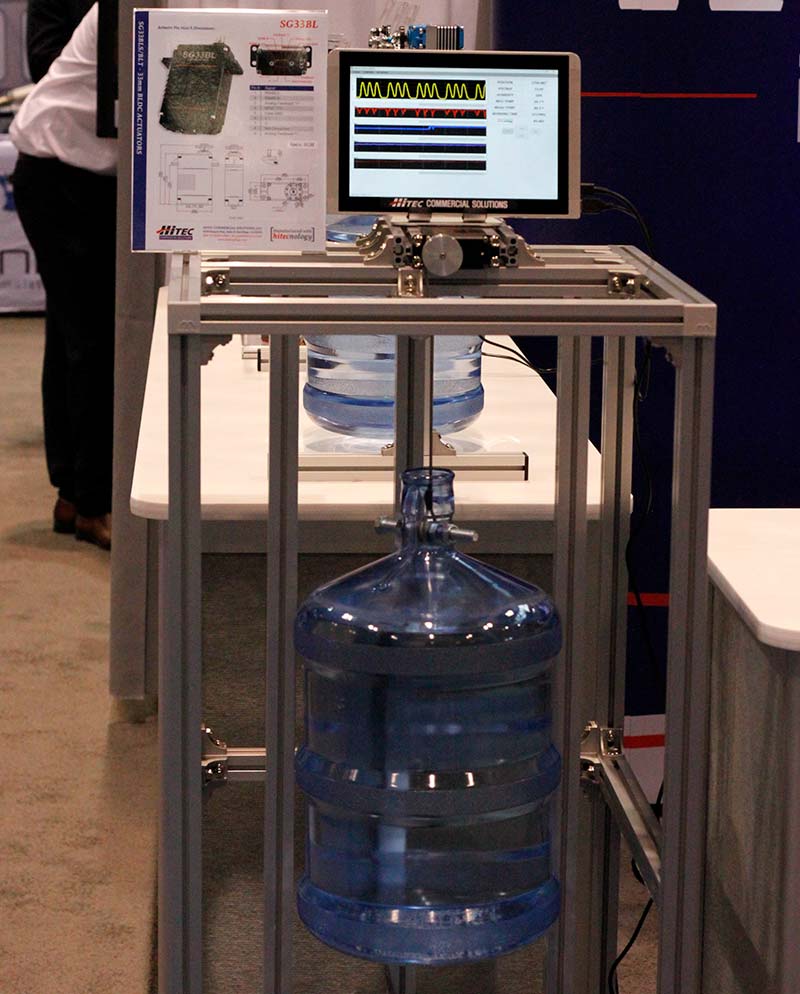
Hitec’s mighty SG33BL servo “pumping iron.”
The SG33 Hitec servo (which is now available with a CAN bus and Ardupilot® and PX4® open source protocols) featured hardened steel gears and magnetic encoders; is completely dustproof; and can remain submerged for up to 30 minutes at a depth of one meter with no water ingress.
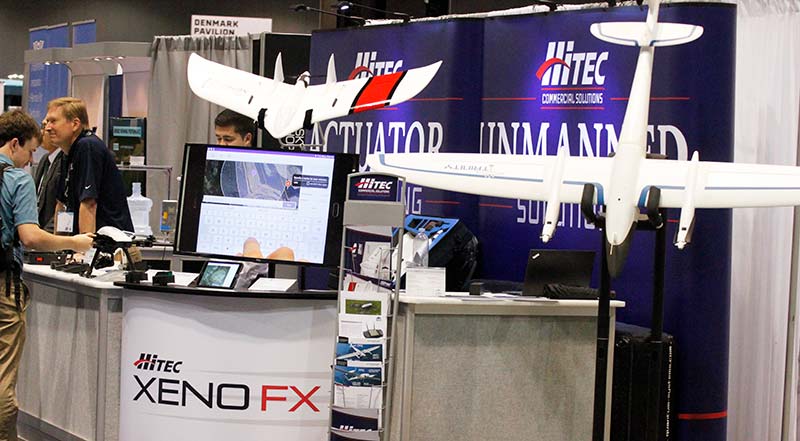
Hitec’s booth showed off powerful servos and their new drone.
The servo — along with many of the other servos in the professional line — will be incorporating the reliable UAVCAN communication protocol which is an extension of the tried and true Controller Area Network (CAN) bus.
CAN bus is a communication protocol that allows microcontrollers and compatible devices to communicate with each other without the use of a host computer.
Developed for the automotive industry, its savings in equipment and wiring (all of which is equal to weight, weight, and more weight!) is driving early adoption of CAN and UAVCAN into the UAV systems almost as a default.
A high number of components, devices, systems, and even engines on display at the show boasted CAN features. These will be standard on many unmanned systems. The flexibility of the protocol also allows for onboard storage and later download of that stored data of operating conditions for later analysis.
If you’ve ever built a robot, you know how valuable it can be to understand what the robot was “thinking” at the time — especially if something went wrong. Hitec, while familiar to any hobbyist, is a serious and well-respected supplier to major robot designers and manufacturers. Their booth sported a wide array of actuators and feedback equipment in many interesting forms.
They even have a line of drones! Hitec Commercial Solutions has partnered with Straight Up Imaging (SUI) and Quantum Systems to release the Xeno FX. The Xeno FX is a fixed-wing area imaging and monitoring drone that is both efficient and cost-effective.
To build on the innovations coming into the show from vendors, users, and innovators, XPONENTIAL featured a lineup of keynote speakers and industry experts who held talks on every imaginable topic each day.
Some extremely timely discussions regarding things like airspace usage for drones were covered by panels that included officials from the FAA. The keynote talks focussed on three relevant areas: where we are now; how do we make that work; and where are we going next.
Besides the keynote talks and panels, the AUVSI pulled out all the stops and arranged to have more than 150 sessions presented by over 300 speakers, providing discussions and answers to many challenges faced by developers and users working in the industry today. There was plenty of opportunities to showcase innovative solutions and share and discuss what will become industry best practices.
Another topic that will become of interest to users, regulators, insurers, and the general public is the concept of operations beyond visual line-of-sight, or BVLOS. This form of flight is currently illegal in most jurisdictions for drones according to FAA and local rules. It’s a non-issue with most ground-based robots that can simply stop (there are no rules regarding ground-based robots), but a drone cannot simply halt.
In the case of most commercial drone operations, a pilot is required and at least one observer, who must be present and in communication with the pilot to alert him/her to possible conflict with aviation traffic, people, and property.
Any camera operations must usually employ a dedicated camera operator. This means that just to take a video of something as simple as a real estate property, you could need as many as three or more trained operators to fly the drone. That’s more people than it takes to fly a 737 from New York to L.A.!
Of course, that doesn’t change the fact that BVLOS operation is essential to many applications; for example, emergency response. Firefighters could launch drones while they are still en route to a fire and get a “heads-up” look to identify risks and quantify the situation well before they arrive at the scene.
Similarly, police would be able to understand the emergency and, in some cases, identify and track a fleeing criminal. Disaster response teams would also benefit from BVLOS capability. The list could go on and on.
Commercial operators like Amazon are counting on BVLOS and AI-based autonomy to make their plans of using drones as package delivery systems come to fruition. The Bell Nexus will rely on it if the autonomous “Air Taxi” system is ever to become a reality.
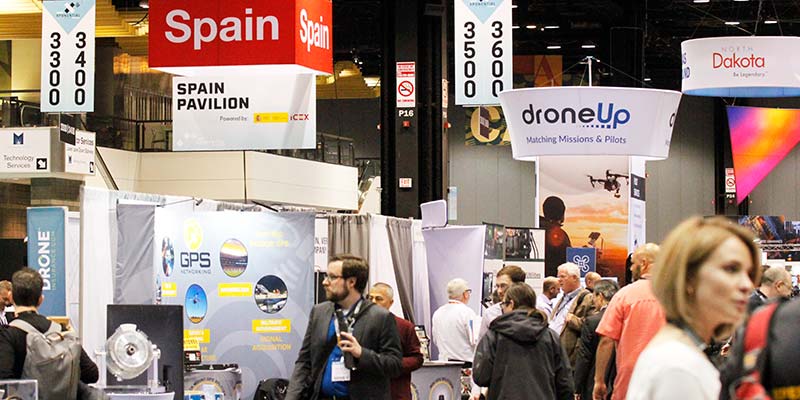
The busy show floor.
However, do not fear! There were quite a few companies touting their new BVLOS systems and software. It’s not just the work of science fiction writers; there will be autonomous drones in the skies, moving packages and people around urban centers.
As more and more products become available to consumers through online sales sites, the need to deliver these products is on the rise. Using drones to deliver everything from pizza to toasters is an excellent way to reduce road congestion and the associated wear and tear on our transportation infrastructure.
Moreover, speaking of infrastructure, the show sported a plethora of companies that produce the products to keep all this technology moving.
Gears, wheels, and propellers dotted the “showscape,” and although I should not have been surprised, I didn’t expect to see such a large number of companies engaged in the business of connectors!
While it might sound a bit dull and boring, all the controllers, devices, engines, and networks of sensors need to connect electrically. The connections must be reliable, and in the case of combat, they need to be perfect!
Keeping dust and dirt out of the contacts is as important as keeping them dry and connected. In situations where the operating environment is in close proximity to petroleum-based engines, you also have oil, fuel, and vibration to worry about.
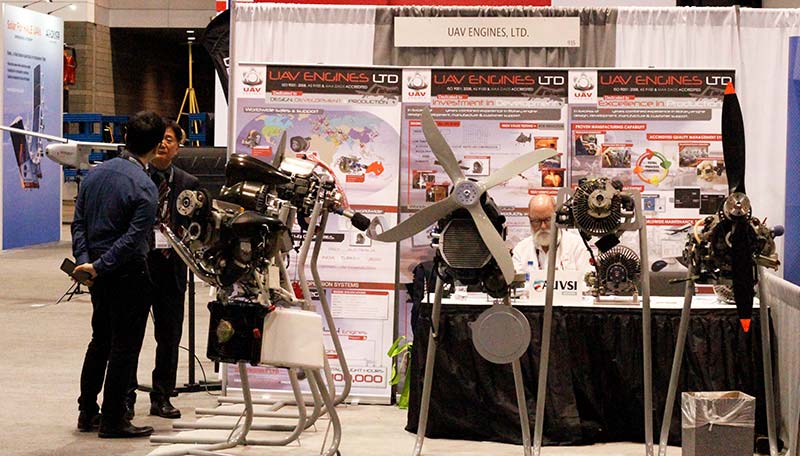
Power systems of all sizes. UAV Engines has been making rotary engines for 25 years.
The connectors in a system are as necessary as the high-tech controllers they are attached to! A mundane plug — if not correctly designed for the task — could ruin an entire mission or worse: cause the loss of the whole robot.
This is doubly important in marine environments where water pressure could be a factor.
Unexpected to me were the anti-drone technologies. In the wake of drone attacks in England and Africa, the market is flooding with new systems to deal with malicious activities involving drones.
These systems include directed energy weapons that fry the electronics of the drone or burn through the body, and RF “fences” that prevent drones from entering protected areas. My favorite was the “Drone Killer.”
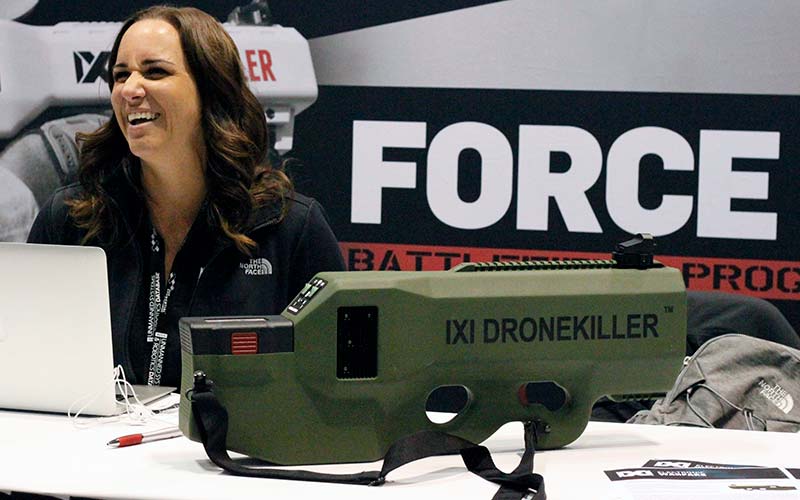
DroneKiller: An RF jamming, drone smacking gun.
It looked like a big fun gun you might find in a video game. It’s designed to send a cone of RF noise that you point at the drone. When the noise hits the receiver in the drone, the signal is lost, and the drone either crashes or returns to the start position, which can then be tracked right back to the bad guys.
In time, with proper planning and solid engineering, all these things will come together, and we will live in a new world where robots work side-by-side at the same places humans live and work.
Robotic street sweepers will keep our roads clean. Wandering robotic arms will pick up trash, while other automatons cut the grass in our parks. They will drive us to work and pick us up again when the day is over.
I can easily see a day when the sound of drones buzzing back and forth becomes a natural part of the soundscape of an urban center. I can envision a time when the sound of a passing drone will be no different from the distant hum of traffic or the occasional car horn or emergency siren.
As these technologies advance, we will need to develop ways to incorporate this technology into our society safely and with the highest levels of public acceptance ... and we will do it.
The advance of robotics in the world is something to be embraced. So many menial and dangerous tasks will no longer require risking humans to complete them. Lives will be saved, and economies will grow. Space will be explored; the seas will be delved and science advanced.
Robots will be part of our commitment to clean the earth and remove pollutants from the sea, waterways, forests, and fields. We’ll be able to use robots to recover plastic, dangerous chemicals, and products of radioactivity from the environment. Robots will be part of the human condition, and the human condition will be better for it.
So, carry on with your experiments! Continue your research. Encourage young people to explore and build engineering projects and explore science. Reward new ideas and forward thinking.
With thanks in no small part to organizations like the AUVSI, the next age is upon us. SV
WHO IS AUVSI?
The Association for Unmanned Vehicle Systems International (AUVSI) — the world’s largest nonprofit organization dedicated to the advancement of unmanned systems and robotics — represents corporations and professionals from more than 60 countries involved in industry, government, and academia. AUVSI members work in the defense, civil, and commercial markets.
Interview with the President
Brian Wynne, the President and CEO of the Association for Unmanned Vehicle Systems International (AUVSI), was willing to answer a few of my questions:
SERVO: Can you summarize the purpose of the show?
Mr Wynne: XPONENTIAL is the largest event in the unmanned systems and robotics industry where technologists, regulators, and end-users from across the commercial and defence sectors gather to share ideas, collaborate across markets, capitalize on best practices and emerging trends, and harness the power of unmanned technology for multiple business sectors.
SERVO: What are the big trends you are noticing at the show?
Mr Wynne: People often compare unmanned systems to the popular cartoon, “The Jetsons,” which was about the space-age family of the future. Displays at this year’s XPONENTIAL — such as Urban Air Mobility (UAM) systems and other advancements in autonomy — show how we may be living like the Jetsons in the not too distant future. UAM received a lot of attention at XPONENTIAL, with several exhibits by companies that are developing these compact-sized autonomous aircraft to carry passengers and cargo, and address many transportation challenges such as highway traffic congestion and underserved markets. It was also fascinating to see how GPS and mapping technologies are becoming more sophisticated and enabling advanced operations and applications. This year’s show also saw an increase in artificial intelligence for air, as well as ground and maritime systems.
LINKS
www.os-engines.co.jp/OS_professional/index_e.html
www.bellflight.com/company/innovation/nexus
https://uncrate.com/drone-killer
Article Comments